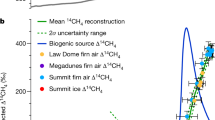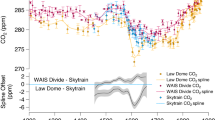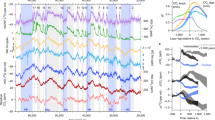Abstract
Arising from Kai, F. M., Tyler, S. C., Randerson, J. T. & Blake, D. R. Nature 476, 194–197 (2011)10.1038/nature10259
To understand the reasons for global CH4 changes since the 1990s, Kai et al.1 evaluated a combined record of observed tropospheric CH4 mole fractions as well as δ13C-CH4 and δD-CH4 measurements from mid latitudes of both hemispheres. Their data set shows a strongly decreasing inter-hemispheric difference (IHD) in δ13C-CH4 from −0.24 ± 0.11‰ during 1989–1993 to −0.10 ± 0.04‰ during 2001–2005, which they largely attribute to decreasing rice emissions during the last two decades. Here we show that the experimental data used by Kai et al.1 are probably biased because the authors used only one continental mountain station (Niwot Ridge, Colorado, USA) as representative of the entire Northern Hemisphere, thereby incorrectly determining the IHD of δ13C-CH4. Our more comprehensive data set—representing background air in both hemispheres—shows that the IHD of δ13C-CH4 has changed by less than 0.05‰ since 1990; the conclusion drawn by Kai et al.1 of a significant reduction of NH microbial sources is, thus, not constrained by our data.
This is a preview of subscription content, access via your institution
Access options
Subscribe to this journal
Receive 51 print issues and online access
$199.00 per year
only $3.90 per issue
Buy this article
- Purchase on Springer Link
- Instant access to full article PDF
Prices may be subject to local taxes which are calculated during checkout

Similar content being viewed by others
References
Kai, F. M., Tyler, S. C., Randerson, J. T. & Blake, D. R. Reduced methane growth rate explained by decreased Northern Hemisphere microbial sources. Nature 476, 194–197 (2011)
Bousquet, P. et al. Contribution of anthropogenic and natural sources to atmospheric methane variability. Nature 443, 439–443 (2006)
Monteil, G. et al. Interpreting methane variations in the past two decades using measurements of CH4 mixing ratio and isotopic composition. Atmos. Chem. Phys. 11, 9141–9153 (2011)
Quay, P. et al. The isotopic composition of atmospheric methane. Glob. Biogeochem. Cycles 13, 445–461 (1999)
Lassey, K. R. et al. Recent changes in methane mixing ratio and its 13C content observed in the southwest Pacific region. J. Integr. Environ. Sci. 7, 109–117 (2010)
Miller, J. B. et al. Development of analytical methods and measurements of 13C/12C in atmospheric CH4 from the NOAA Climate Monitoring and Diagnostics Laboratory Global Air Sampling Network. J. Geophys. Res. 107, 4178 (2002)
Dlugokencky, E. J. et al. Observational constraints on recent increases in the atmospheric CH4 burden. Geophys. Res. Lett. 36, L18803 (2009)
Nakazawa, T., Shizawa, M., Higuchi, K. & Trivett, N. B. A. Two curve fitting methods applied to CO2 flask data. Environmetrics 8, 197–218 (1997)
Patra, P. K. et al. TransCom model simulations of CH4 and related species: linking transport, surface flux and chemical loss with CH4 variability in the troposphere and lower stratosphere. Atmos. Chem. Phys. 11, 12813–12837 (2011)
Author information
Authors and Affiliations
Corresponding author
Ethics declarations
Competing interests
Competing financial interests: declared none.
PowerPoint slides
Rights and permissions
About this article
Cite this article
Levin, I., Veidt, C., Vaughn, B. et al. No inter-hemispheric δ13CH4 trend observed. Nature 486, E3–E4 (2012). https://doi.org/10.1038/nature11175
Received:
Accepted:
Published:
Issue Date:
DOI: https://doi.org/10.1038/nature11175
This article is cited by
-
Rebalancing the global methane budget
Nature (2016)
-
Spatiotemporal variability of methane over the Amazon from satellite observations
Advances in Atmospheric Sciences (2016)
-
Emissions of methane from offshore oil and gas platforms in Southeast Asia
Scientific Reports (2014)
-
Three decades of global methane sources and sinks
Nature Geoscience (2013)
-
Long-term decline of global atmospheric ethane concentrations and implications for methane
Nature (2012)
Comments
By submitting a comment you agree to abide by our Terms and Community Guidelines. If you find something abusive or that does not comply with our terms or guidelines please flag it as inappropriate.



